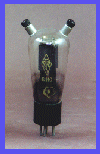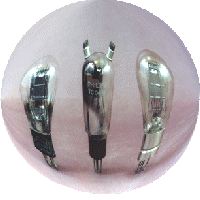

HIGH END
TURNTABLES
and
VACUUM TUBES
AMPLIFIERS
|
|
|
HIGH END |
![]()
![]()
These amplifiers are not in
production at the moment they are available
on demand and only by quantities).
Your demands are wellcome.
The MONO BLOC TRIODE is fitted with the famous russian power triode 6 C33CB military quality.
Well-known for their harmonic richness mono triode amplifiers were until now limited to modest modulated powers of about 3 to 10 efficient watts.
This limite is henceforth exceeded by the MONO BLOC TRIODE which modulates easily more than 30 efficient Watts.
It is now possible to use this amplifier with speakers of low efficiency (90 dB 1W 1m) by preserving all the dynamics of the musical recording.
In brief, the MONO BLOC TRIODE is all the richness of the triode on speakers of acceptable dimensions in your sitting room.
![]()
The MONO BLOC TRIODE has been designed to satisfy the most demanding of Audio enthusiasts especially the ones who cannot listen to anything but a Triode tube amplifier. However this piece is not an imitation of an existing model ; originality attends its every step. For example, direct coupling between the power Triode and the preceding stage is achieved without any other connection but a straight wire. This implies the use of huge, stable power supplies which also have a low internal impedance - a difficult feat in itself ! In the MONO BLOC TRIODE there are four power supplies, two for high voltage and two for the tube filaments. The supply of the output stage is as follows : rectification (use of 6 amp rectifiers), inductance of 1,5 Henry (iron core insaturated), plus two 1000 pFarads 400 Volts parallel capacitors. In an effort to further reduce power supply impedance the unusual and expensive step of using a transformer with grain oriented core is employed.
Circuitry broadly defined;

The input stage (constituted SRPP) uses half of a pair of 6SN7s, with a propylene
capacitor connecting it to the following stage.
This stage in turn also uses half of a pair of 6SN7s ( again SRPP) and is wired straight to
the grill of the output tube, a 6C33 CB Triode. It, in turn, is wired to the output transformer
which is also grain oriented. For the purposes of preserving the dynamics
the power supply voltages of the SRPP stages are raised to 480 and 740 Volts respectively.
All the tubes are of military quality. The 6C33 CB, of Russian origin is a power triode with very low internal resistance. Its glass manufacturing is clearly of high quality as well as its molded graphite plate and the innumerable spacers of reinforcement and stability. The 6SN7s are American and are JAN approved. Their glass bulbs and internal components clearly display the outstanding quality of these tubes.
The goal of the amplifier's housing is to reduce resonances and render it structurally stable. The top plate is stainless steel, the bottom is steel covered with epoxy-based paint. The frame is reinforced by struts of galvanized steel. The signal carrying
portion of the amplifier has point to point wiring, only the power supply uses a high quality printed circuit board.
All testing has been done using the computer program CLIO, and is presented here without any averaging or alteration. Irregularities which appear in the graphs reflect the limitation of the computer program, and not of the amplifier. These simple data are offered for the reader's own interpretation.

Analysis of harmonic distortion.
A pure 1000 Hz signal is provided by the computer. At 1 Watt the harmonic gradation is perfect. Since the amplifier functions at this level most of the time, the importance of this can be readily appreciated. At 10 Watts the harmonic gradation is very smooth, but an ascent of the 7th and 9th harmonics can be seen; yet they are found at a relative low level of about -60dB. At 30 Watts, with the amplifier at full power, the balance of the 7th and 9th harmonics is re-established. Clipping is soft, with an ever slight aggressiveness being the only noticeable change.
Analysis of frequency response
The computer program provides a complex impulse signal which it recreates from a
traditional frequency response ( with the exception of discontinuities).
Regretfully this computer program does not extend its testing to frequencies lower
than 20Hz and higher than 20KHz because no anomalies can be detected at 1 Watt as well as at
30 Watts.
Analysis of phase shift response
Using the same program as outline above, it shows a dephasing of +18° at 20Hz, and -5° at 20KHz. This very fine performance is reflected in the constancy of this dephasing in all three power modalities, the curves at 1 Watt, 10 Watts and 30 Watts being practically superimposable, a definite sign of stability.
Power Supply Impedance
There is an explanation for all these superb measurements, and this chapter could hold many more pages, but let us limit the discussion to power supply impedance. Again our computer program provides a variable frequency sinusoidal signal. It shows that the impedance of a 1000 pF 400 Volt capacitor ( used in parallel in the amplifier itself but measured separately) is 1,6 Ohm at 100 Hz and 8 Ohms at 20 Hz. This is practically identical to the theory ideal ( Z = 1/CW), and confirms that these capacitors actually constitute very low series resistances. A lot of transistor amplifiers do not have such good power characteristics; here we are dealing with a tube amplifiert.... Well , it's time to conclude.
Mesures
The sheets have been realized on a Personal Computer compatible with analyses application
of measure CLIO.
All these curves are made automatically and are printed without any retouch.
Discontinuities that appears, shows the limits of the computer possibilities but not the
amplifier failures. To interpret correctly these curves, we have to smooth the lines.
For a maximum objectivity, this is left to the reader of these documents
Analyses Curves
|
To see a curve, CLICK on the link below |
| Power requirement | 220 Volts |
| Power consumption | 250 Watts |
| Power output | 30 Watts at 8 Ohms |
| Input Sensitivity | 0,4 To 1 Volt |
| Power bandwidth | 20 Hz 60 KHz |
| GENERAL | |
| Power : | Three terminals sockets CEE Standard |
| Input : | RCA socket |
| Output : | Terminal posts for 4 mm banana plug |
| Dimensions : | 380 (W) x 180 (H) x 300 (D) |
| Net Weight: | 16 Kg |
![]()
 |